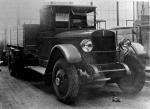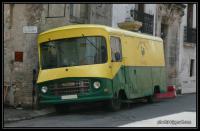AMO » 2
In 1929, the American truck Autocar SD with a payload of 2 tonnes was chosen as a replacement for AMO F-15. Russian constructors decided to increase payload using a heavier Timken rear axle. As a result, payload of the Russian Autocar was increased to 2.5 tonnes.
At the beginning, the new trucks were assembled at the Moscow Automobile Plant from the US parts except for cabs and cargo platforms, which were made in by their own. The trucks were named AMO 2. The parts weren't sent by The Autocar С°, the manufacturer of automobiles, but by the suppliers of components for them (The Autocar С° was a typical assembly plant with almost zero production of its own): engines — Hercules, frames — Parshee, clutches — Long, gearboxes — Brown-Lipe, steering gears — Ross, drive shafts and hinges — Spicer, front and rear axles — Timken, wheels — Budd, hydraulic brakes — Lockheed.
Soviet plants were not accustomed to working with so many suppliers, and this created confusion since very often the parts in different batches differed significantly from each other in design and characteristics, and their arrival was extremely uneven. As a result, AMO did not manage to debug the assembly of the same type of trucks, even within the same model.
In addition, trucks accepted for production without any tests and operating experience had many inherent flaws which immediately appeared in different problems. For example, the Timken drive axle had not enough ground clearance under the crankcase (only 260 mm). In addition, it required changes in the driveline and drive brakes, because unlike the hydraulic brakes of the Autocar drive axle, the Timken axle had a mechanical drive. As a result, AMO 2 received two brake systems — hydraulic in the front and mechanical in the rear.
In 1930-1931, 1521 flatbed trucks AMO 2 and 109 chassis were assembled, in total — 1630 units.








